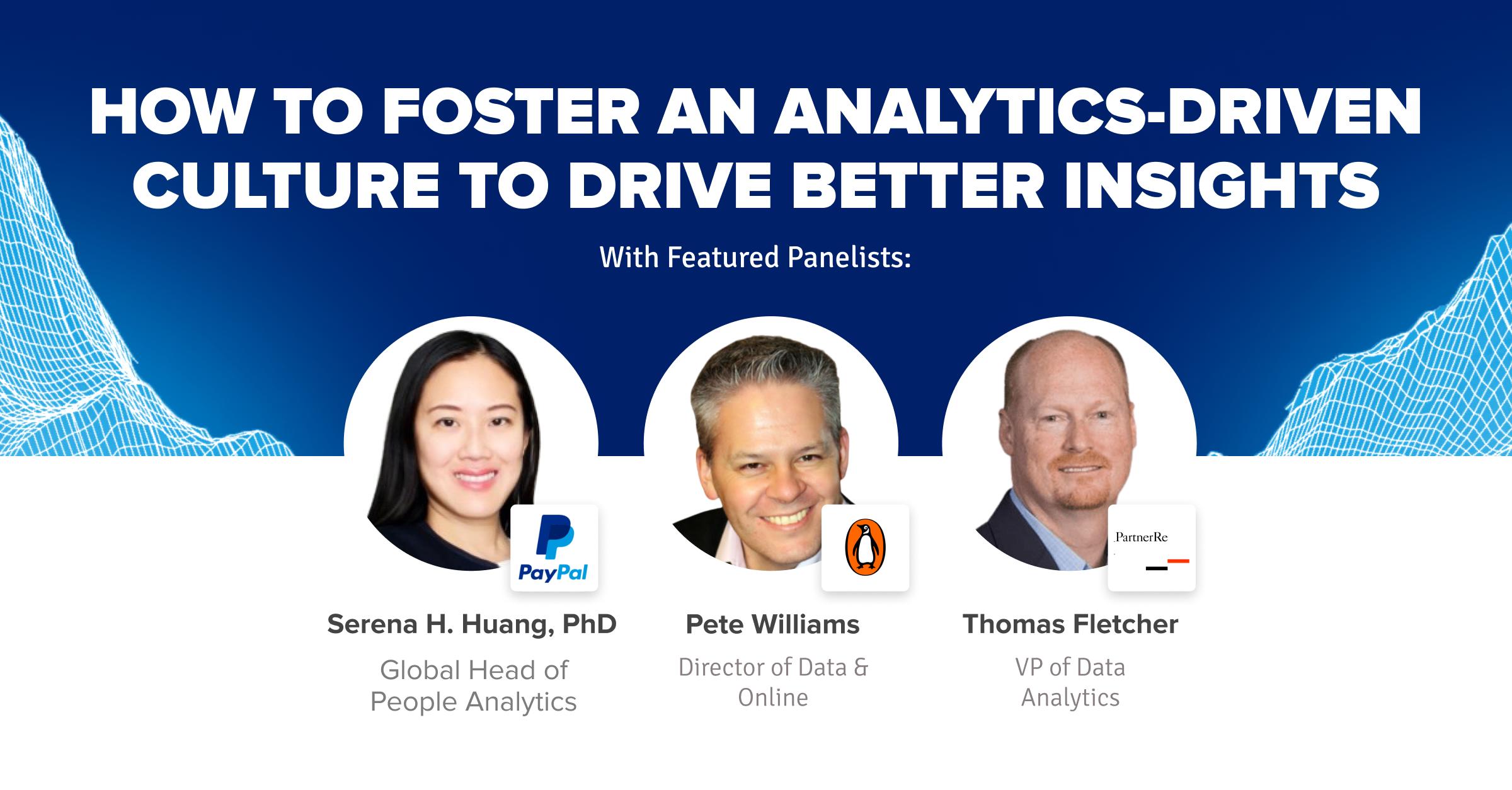March 5, 2019
What’s the best BI tool for Hadoop?
I recently spoke with a roundtable of data and culture industry experts about how to foster an analytics-driven culture to drive more actionable, valuable insights. We discussed how organizations can become data leaders, the importance of change management, and why data storytelling matters.
The data and culture experts I spoke to included: Tom Fletcher, vice president of data analytics at ParterRe, Serena Huang, Ph.D and global head of people analytics at Paypal, and Pete Williams, director of data and online at Penguin Random House.
Read on to find out how to foster an analytics-driven culture that derives real value from its data models and AI implementations.
Why Many Data Projects Are Unsuccessful
According to Tom Fletcher of PartnerRe, only 1 in 6 data model implementations is successful. What’s more, one Gartner report found that, although nearly half of CIOs are planning to deploy AI, 85% of all AI projects fail to reach the finish line.
This is a pretty dismal figure. So what separates successful data model implementations from failures? According to Fletcher, it comes down to planning, analytics-driven culture, data storytelling, and change management.
“Change management is the careful consideration of what is going to change,” said Fletcher. “A lot will change, or else you won’t have an impact.”
There are a few key elements business leaders need to identify during the change management process to achieve buy-in and ensure their teams successfully adopt new technologies.
“You need to figure out what the resistance is,” said Fletcher. “People need to be dissatisfied with the current state. There needs to be a vision for the future and there need to be first steps towards that future vision. That’s what creates readiness.”
By identifying and addressing resistance, your organization can get one step closer toward its ideal future state.
How Culture Influences Data Insights
Both Fletcher and Serena Huang of Paypal stressed the importance of analytics-driven culture in achieving a successful AI project implementation.
“If you ignore the underlying culture, you’re not going to be successful,” said Fletcher.
According to Fletcher, business leaders need to consider a few questions throughout the implementation process to assess whether their organization will have an analytics-driven culture that promotes the use of valuable insights:
- Does the implementation work in concert or in contradiction of the prevailing culture?
- What values are impacted?
- Have new norms been established?
- What are the new best practices?
- Do people think they will be rewarded or inadvertently punished for using the new system?
Huang emphasized that data storytelling is the key to success, and ultimately determines whether businesses actually use the insights generated by their data models. She advised that business leaders think of the “3 Cs” before, during, and after implementations.
- Clear. All data must be clear. “Whether you are sending someone a PowerPoint presentation for their data analysis or creating a data dashboard to consume, if you have to explain how to read it or interpret it, it’s not clear enough,” Huang said.
- Care: People need to care about the data you are sharing with them. “Relationships-building comes in handy here,” Huang added. “Beforehand, you have to be creating analytics for your audience on something they care about.”
- Call to Action: Data must promote a call to action. Huand advises, “Always make it clear what the audience must do with the information. Tell the audience what you want them to do with the data analysis.”
In tandem with effective data storytelling, Huang said business leaders must focus on stakeholder management.
“Ask yourself, will the analysis tell my stakeholders something they don’t already know? Will the analysis change any of the decisions my stakeholders are going to make?”
These questions will help to inform whether the data analyses will drive measurable business impact. Huang urged business leaders to consider whether the problem the data addresses is worth solving before initiating any analytics or AI projects.
If it isn’t worth solving, stakeholders won’t care about the implementation, which inevitably leads to failure. However, if the problem is worth solving, there will be top-line or bottom-line impact that stakeholders can point to as justification for the effort required by the project.
How to Increase Analytics Maturity
All organizations that engage in AI or data model implementation want to achieve the highest possible level of analytics maturity.
Once business leaders have laid the groundwork for an analytics-driven culture, increasing analytics maturity gets a lot easier.
Pete Williams outlined the three activities that enable organizations to achieve higher stages of analytics maturity. He simplified these activities to the “3 Es:”
- Establish: Entails seeking sponsorship and sign-off from executive leadership for a project, defining the use case that initiates the project, building the foundational data platform, and initiating a process for data governance.
- Enable: Involves pushing for data literacy across the organization, reviewing organizational structures and roles, finding data translators, and ensuring that leadership sponsors the data use cases. Creating data steward networks and focusing on value creation also help to enable the use of analytics across the business.
- Exploit: Denotes letting data guide decisions, having more advanced use cases like machine learning or AI, and driving value from the data.
Ultimately, moving through each phase of analytics maturity will help to firmly establish an analytics-driven culture. And being in a data-driven culture results in better-informed decision-making.
“It feels like a culture of curiosity,” said Williams. “Moving from a rearview to forward-thinking, analytical reinforcement.”
Watch the full discussion I had with these data leaders about How to Foster an Analytics-Driven Culture to Drive Better Insights. In addition, we put together an eBook about how to Make AI & BI Work at Scale with 15 thought leaders and experts in the data industry about scaling AI and BI at large organizations.


NEW BOOK